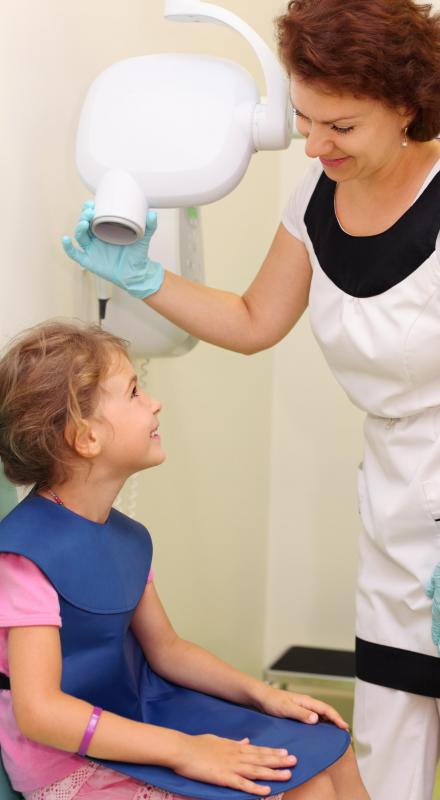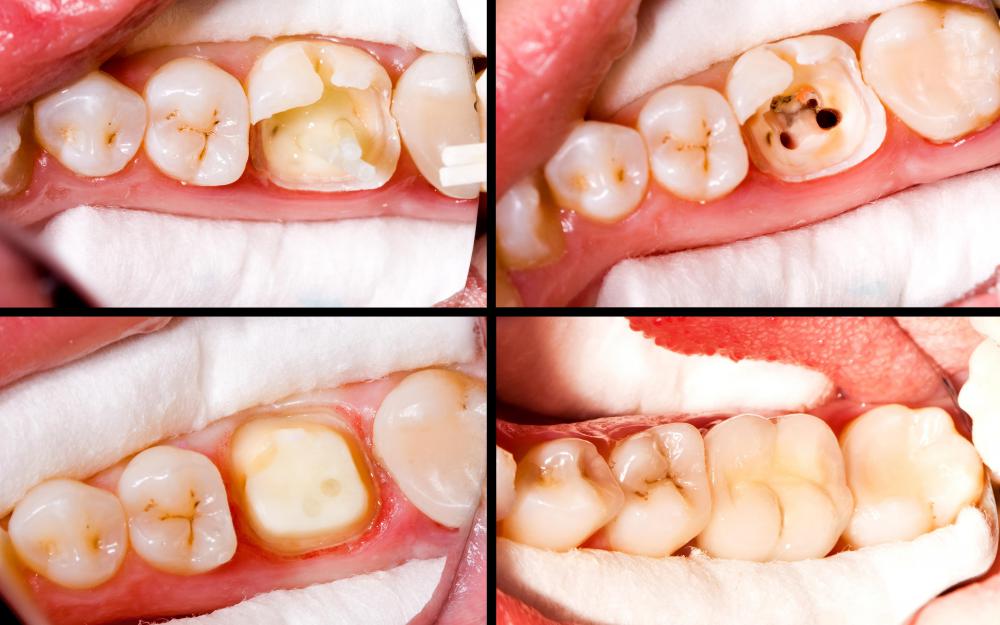At WiseGEEK, we're committed to delivering accurate, trustworthy information. Our expert-authored content is rigorously fact-checked and sourced from credible authorities. Discover how we uphold the highest standards in providing you with reliable knowledge.
What Should I Expect from a Dental Cleaning?
A dental cleaning is a fairly routine procedure that is rarely painful. Those who fear dentists or who have marked tooth sensitivity may feel more discomfort than the average patient. Additionally, people who have not had their teeth cleaned in a long while may expect to experience a longer cleaning, and some extra pulling or scraping to remove plaque from teeth. For most people, however, a dental cleaning is more inconvenient than painful.
Most dental cleanings take between 30 minutes and an hour. If the cleaning is part of a yearly check-up, the dentist may also take X-rays to check for cavities. A dental hygienist usually performs most of the cleaning. The dentist will normally take a last look, and perhaps perform some difficult plaque removal toward the end of the cleaning, as well as evaluate the gums for gum disease.

People usually don't need pain medication for a dental cleaning. Some patients are made so nervous by dentists that they may ask for nitrous oxide though. Alternately, a patient might take a tranquilizer about an hour before the appointment to help with anxiety. In cases of extreme anxiety, some dentists use a method called sleeping dentistry, where a patient can be medicated and essentially sleep through a procedure.

Dental hygienists generally use several tools during a dental cleaning, including a tooth polisher and a scaler. Tooth polishers buff teeth and eliminate tiny pieces of plaque. They generally have several different sized heads for cleaning hard to reach places. Scalers look a bit like metal hooks and are used to remove hard plaque, especially between teeth. Some people find the use of a scaler uncomfortable, depending on their sensitivity level, pain threshold, the length of time since the last cleaning, and the extent of plaque build-up.
Dentists may also employ a device that shoots water into the mouth, so the person can rinse out plaque several times during the cleaning. In some cases, a dentist may merely use mouthwash for this purpose.

Those getting a dental cleaning should also expect the dentist to inquire about their home brushing and flossing activities. Dentists may lecture patients during a cleaning if they have a lot of plaque or if they don't regularly brush and floss their teeth. If a person is regularly caring for his or her teeth at home, and plaque build-up is still significant, this may indicate the need for more frequent cleanings.

Dental cleanings often conclude with advice about how to care for teeth at home, and scheduling any appointments needed for more extensive services, like filling cavities. People with busy dentists should schedule their next cleanings well in advance, so as to keep regular six-month cleaning appointments.
Anyone with a heart condition or who has undergone heart surgery should let the dentist know prior to the day of the teeth cleaning. People with heart problems or heart defects are at high risk for developing a condition called bacterial endocarditis, which can seriously affect the heart. The only treatment needed prior to a dental cleaning, unless otherwise instructed, is a dose of antibiotics an hour before the cleaning. If a dentist does not know the proper dosage, then the person should contact his or her physician. Usually dentists will know the dosage, but if in doubt, it's also possible to find information from the American Heart Association, which lists all guidelines for bacterial endocarditis prevention.
AS FEATURED ON:
AS FEATURED ON:



















Discussion Comments
I went to the college for a free cleaning. At 1 p.m., I consented to the examination. At 3 p.m., the student reread the consent form after mentioning a dental block. I did not consent at the second reading and left. My teeth were not yet cleaned. The oral surgeon used a dental block because I was under general anesthesia having wisdom teeth removed.
I went to a new dentist and was not at all impressed. I went for my six month check-up and cleaning. The doctor took X-Rays and did an exam. He felt that my pockets were deep and that I needed the rooting and scaling procedure. That's fine, but he didn't even provide a regular cleaning while I decide about the deep cleaning. Is this normal procedure?
To anon284053: If periodontal disease evaluation is the expertise of dental hygienist and not a dentist, why then a hygienist cannot diagnose the condition and have to be diagnosed by a licensed dentist? Please provide accurate information.
It is unwise to state that the DDS will come in near the end of the appointment to "perform some difficult plaque removal as well as evaluate the gums for gum disease".
I have been a Registered Dental Hygienist in the USA for 35 years and never has this happened during my appointments with dental patients. Plaque removal and periodontal disease evaluation is the the expertise of dental hygienists and not the DDS. Likewise, I would not assume expertise in the duties of the Dental Assistant unless I have had an equal amount of training.
@cellmania: I'm a dental hygiene student at a new school in Anaheim, CA. If you're around any schools where you are (you can easily look them up online) students are always looking for patients and it is completely free (at least our program is). It's a great opportunity and we need all the experience we can get! Look up a school and see what you find.
@cellmania: You might want to check with your local health department. Often times, they offer free dental cleanings. Most of the time, it is for children but there may be some that offer the services for adults as well.
Is there anywhere that you can get free dental cleaning?
@dega2010: If you a good dental insurance plan, you are usually allowed two free cleanings per year. However, if you do not have dental insurance, the prices can vary.
The charge for a standard teeth cleaning can range anywhere from $50 to $135.
What is the routing dental cleaning price?
Post your comments